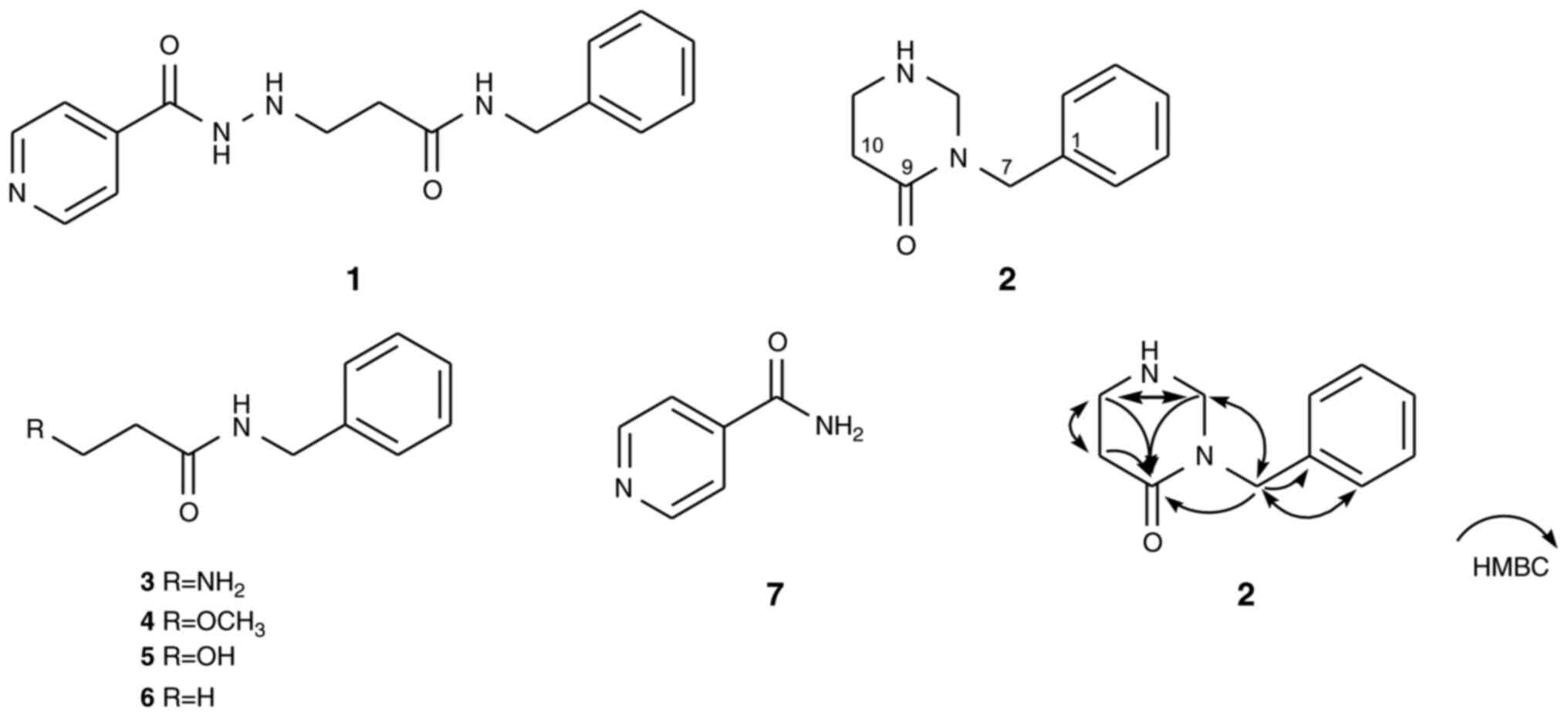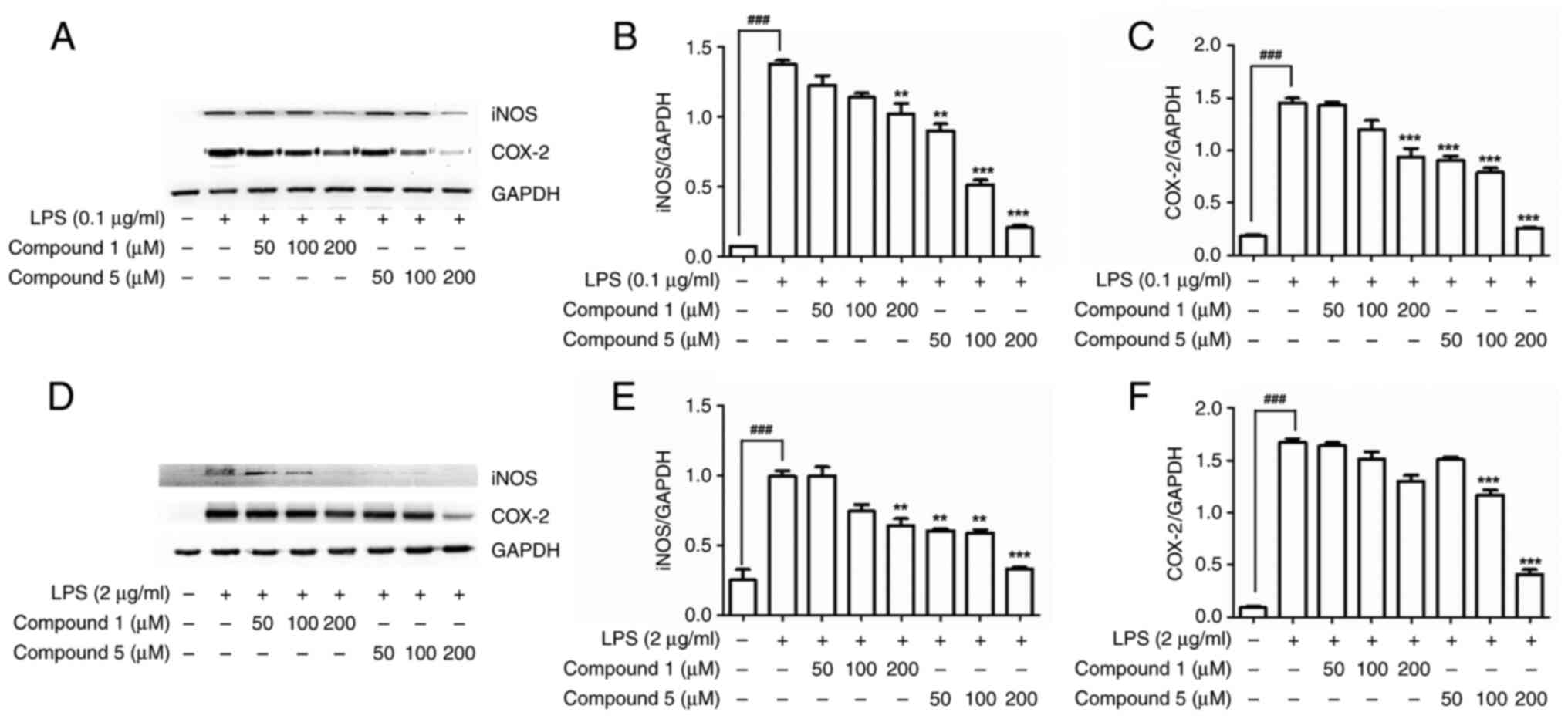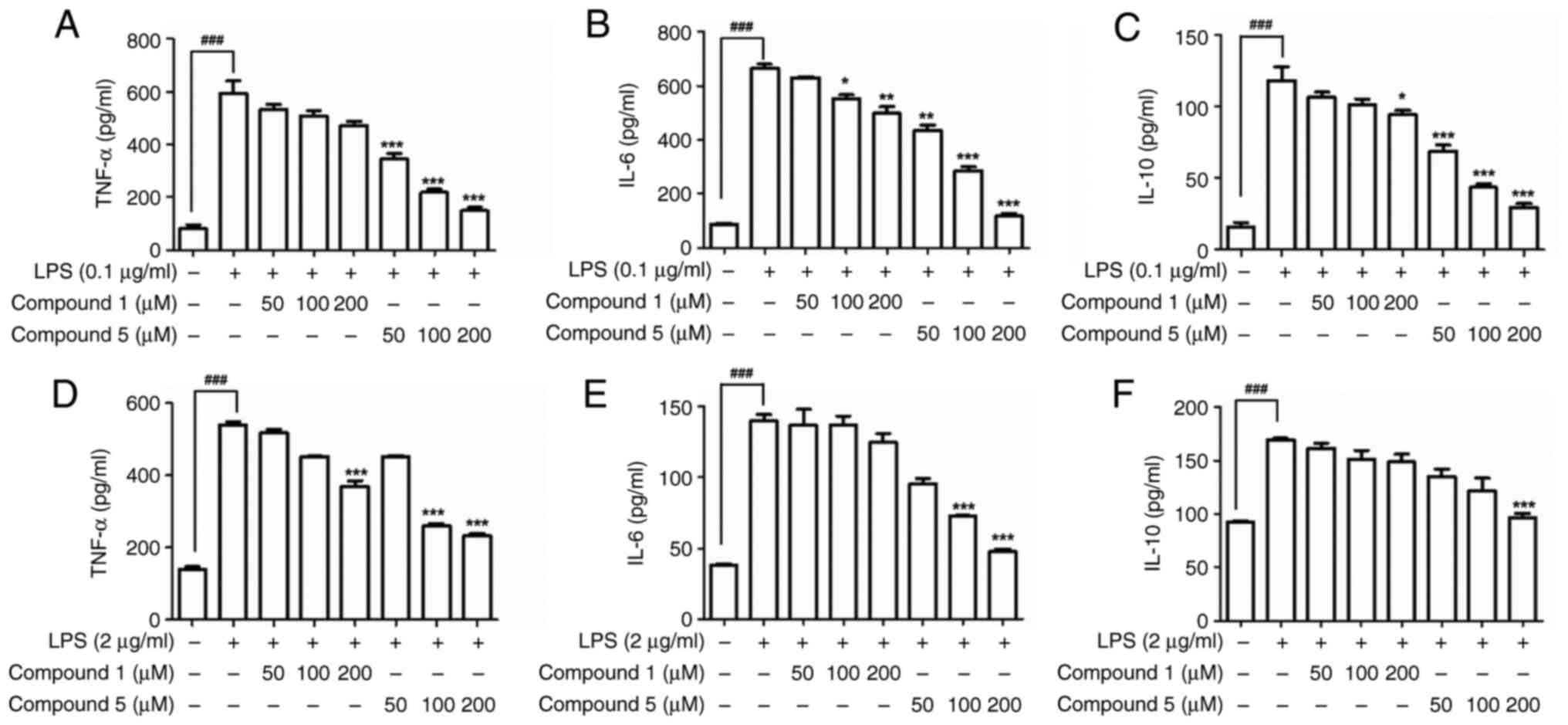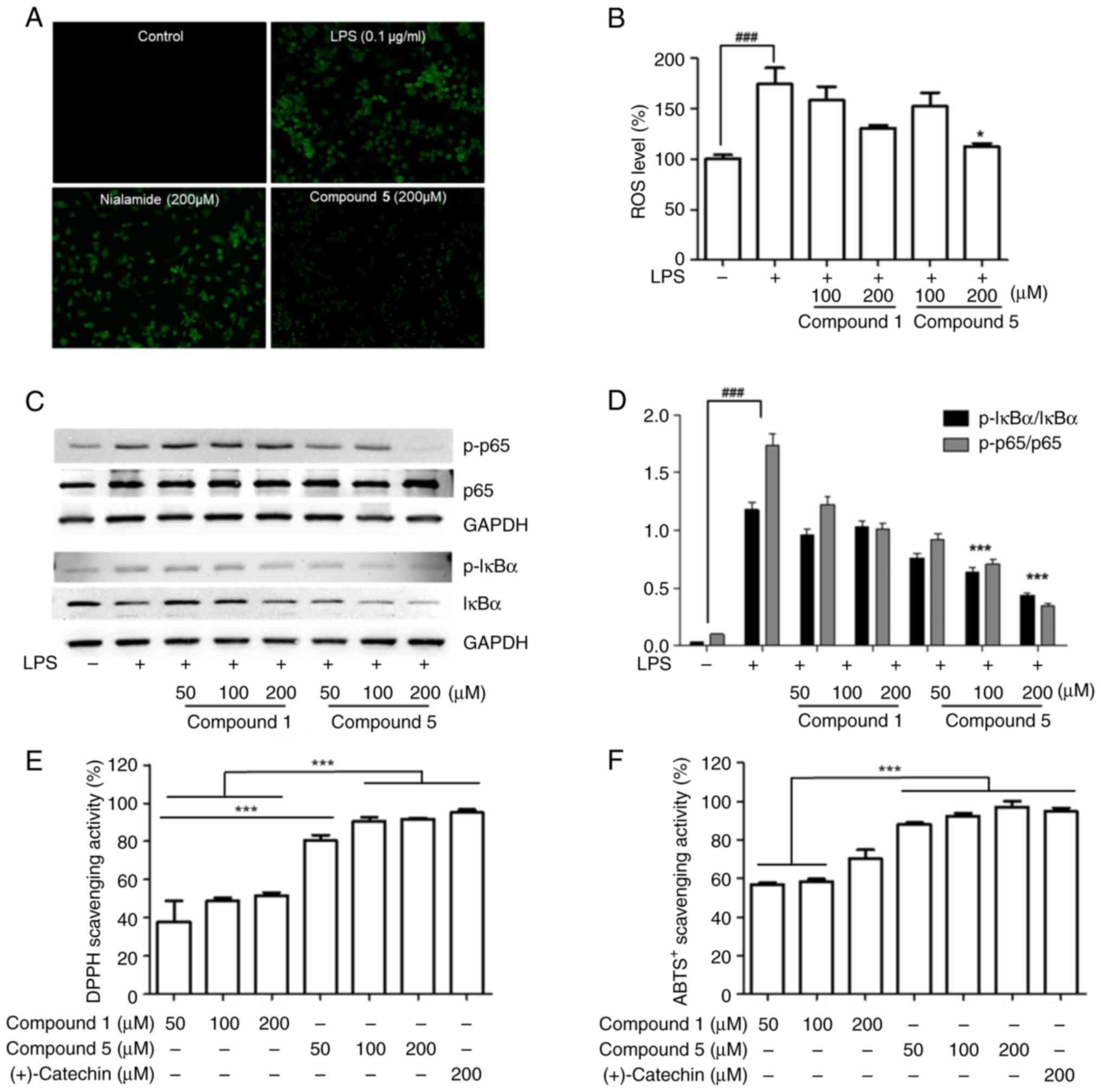|
1
|
Bak DH, Kang SH, Park CH, Chung BY and Bai
HW: A novel radiolytic rotenone derivative, rotenoisin A, displays
potent anticarcinogenic activity in breast cancer cells. J Radiat
Res. 62:249–258. 2021.PubMed/NCBI View Article : Google Scholar
|
|
2
|
Lee EH, Park CH, Choi HJ, Kawala RA, Bai
HW and Chung BY: Dexamethasone modified by gamma-irradiation as a
novel anticancer drug in human non-small cell lung cancer. PLoS
One. 13(e0194341)2018.PubMed/NCBI View Article : Google Scholar
|
|
3
|
Kim TH, Kim JK, Ito H and Jo C:
Enhancement of pancreatic lipase inhibitory activity of curcumin by
radiolytic transformation. Bioorg Med Chem Lett. 21:1512–1514.
2011.PubMed/NCBI View Article : Google Scholar
|
|
4
|
Han Jeong G, Cho JH, Jo C, Lee S, Sik Lee
S, Bai HW, Chung BY and Hoon Kim T: Gamma irradiation-assisted
degradation of rosmarinic acid and evaluation of structures and
anti-adipogenic properties. Food Chem. 258:181–188. 2018.PubMed/NCBI View Article : Google Scholar
|
|
5
|
Xu X, Jeong SM, Lee JE, Kang WS, Ryu SH,
Kim K, Byun EH, Cho YJ and Ahn DH: Characterization of undaria
pinnatifida root enzymatic extracts using crude enzyme from
shewanella oneidensis PKA 1008 and its anti-inflammatory
effect. J Microbiol Biotechnol. 30:79–84. 2020.PubMed/NCBI View Article : Google Scholar
|
|
6
|
Byun EB, Sung NY, Park JN, Yang MS, Park
SH and Byun EH: Gamma-irradiated resveratrol negatively regulates
LPS-induced MAPK and NF-κB signaling through TLR4 in macrophages.
Int Immunopharmacol. 25:249–259. 2015.PubMed/NCBI View Article : Google Scholar
|
|
7
|
Kang SH, Bak DH, Yeoup Chung B and Bai HW:
Transformation of nomifensine using ionizing radiation and
exploration of its anticancer effects in MCF-7 cells. Exp Ther Med.
23(306)2022.PubMed/NCBI View Article : Google Scholar
|
|
8
|
Association AVM. US pet ownership and
demographics sourcebook, 2012.
|
|
9
|
Nieforth LO and O'Haire ME: The role of
pets in managing uncertainty from COVID-19. Psychol Trauma.
12:S245–S246. 2020.PubMed/NCBI View Article : Google Scholar
|
|
10
|
Forrester SJ, Kikuchi DS, Hernandes MS, Xu
Q and Griendling KK: Reactive oxygen species in metabolic and
inflammatory signaling. Circ Res. 122:877–902. 2018.PubMed/NCBI View Article : Google Scholar
|
|
11
|
Sharma JN, Al-Omran A and Parvathy SS:
Role of nitric oxide in inflammatory diseases.
Inflammopharmacology. 15:252–259. 2007.PubMed/NCBI View Article : Google Scholar
|
|
12
|
Ji JD, Lee YH and Song GG: Prostaglandin
E2 (PGE2): Roles in immune responses and
inflammation. J Korean Rheum Assoc. 11:307–316. 2004.(In
Korean).
|
|
13
|
Ostadkarampour M and Putnins EE: Monoamine
oxidase inhibitors: A review of their anti-inflammatory therapeutic
potential and mechanisms of action. Front Pharmacol.
12(676239)2021.PubMed/NCBI View Article : Google Scholar
|
|
14
|
Bortolato M and Shih JC: Behavioral
outcomes of monoamine oxidase deficiency: Preclinical and clinical
evidence. Int Rev Neurobiol. 100:13–42. 2011.PubMed/NCBI View Article : Google Scholar
|
|
15
|
Wimbiscus M, Kostenko O and Malone D: MAO
inhibitors: Risks, benefits and lore. Cleve Clin J Med. 77:859–882.
2010.PubMed/NCBI View Article : Google Scholar
|
|
16
|
Liu Y, Feng S, Subedi K and Wang H:
Attenuation of ischemic stroke-caused brain injury by a monoamine
oxidase inhibitor involves improved proteostasis and reduced
neuroinflammation. Mol Neurobiol. 57:937–948. 2020.PubMed/NCBI View Article : Google Scholar
|
|
17
|
Lougheed KE, Taylor DL, Osborne SA, Bryans
JS and Buxton RS: New anti-tuberculosis agents amongst known drugs.
Tuberculosis (Edinb). 89:364–370. 2009.PubMed/NCBI View Article : Google Scholar
|
|
18
|
Stockert JC, Blázquez-Castro A, Cañete M,
Horobin RW and Villanueva Á: MTT assay for cell viability:
Intracellular localization of the formazan product is in lipid
droplets. Acta Histochemica. 114:785–796. 2012.PubMed/NCBI View Article : Google Scholar
|
|
19
|
Sun J, Zhang X, Broderick M and Fein H:
Measurement of nitric oxide production in biological systems by
using griess reaction assay. Sensors. 3:276–284. 2003.
|
|
20
|
Rosenkranz AR, Schmaldienst S, Stuhlmeier
KM, Chen W, Knapp W and Zlabinger GJ: A microplate assay for the
detection of oxidative products using
2',7'-dichlorofluorescin-diacetate. J Immunol Methods. 156:39–45.
1992.PubMed/NCBI View Article : Google Scholar
|
|
21
|
Blois MS: Antioxidant determinations by
the use of a stable free radical. Nature. 181:1199–1200. 1958.
|
|
22
|
Re R, Pellegrini N, Proteggente A, Pannala
A, Yang M and Rice-Evans C: Antioxidant activity applying an
improved ABTS radical cation decolorization assay. Free Radic Biol
Med. 26:1231–1237. 1999.PubMed/NCBI View Article : Google Scholar
|
|
23
|
Pratt JA, Sutherland IO and Newton RF:
Macrocyclic and macropolycyclic compounds based upon 1,
3-disubstituted propane units. J Chem Soc Perkin. 1:13–22.
1988.
|
|
24
|
Zhao R, Zeng BL, Jia WQ, Zhao HY, Shen LY,
Wang XJ and Pan XD: LiCl-promoted amination of β-methoxy amides
(γ-lactones). RSC Adv. 10:34938–34942. 2020.PubMed/NCBI View Article : Google Scholar
|
|
25
|
Vaidyanathan G and Wilson JW: Reaction of
cyclopropanamines with hypochlorite. J Org Chem. 54:1815–1820.
1989.
|
|
26
|
Johnson DC II and Widlanski TS: A
reversible safety-catch method for the hydrogenolysis of N-benzyl
moieties. Tetrahedron Lett. 45:8483–8487. 2004.
|
|
27
|
Liu Y, Zhou C, Jiang M and Arndtsen BA:
Versatile palladium-catalyzed approach to acyl fluorides and
carbonylations by combining visible light-and ligand-driven
operations. J Am Chem Soc. 144:9413–9420. 2022.PubMed/NCBI View Article : Google Scholar
|
|
28
|
Dhore J, Pethe GB, Wagh SP and Thorat G:
Synthesis, characterization and biological studies of some
triazolyl isonicotinamide. Arch Appl Sci Res. 3:407–414. 2011.
|
|
29
|
Gomez I, Foudi N, Longrois D and Norel X:
The role of prostaglandin E2 in human vascular inflammation.
Prostaglandins Leukot Essent Fatty Acids. 89:55–63. 2013.PubMed/NCBI View Article : Google Scholar
|
|
30
|
Tripathi P, Tripathi P, Kashyap L and
Singh V: The role of nitric oxide in inflammatory reactions. FEMS
Immunol Med Microbiol. 51:443–452. 2007.PubMed/NCBI View Article : Google Scholar
|
|
31
|
Minghetti L: Cyclooxygenase-2 (COX-2) in
inflammatory and degenerative brain diseases. J Neuropathol Exp
Neurol. 63:901–910. 2004.PubMed/NCBI View Article : Google Scholar
|
|
32
|
Ahmad N, Ansari MY and Haqqi TM: Role of
iNOS in osteoarthritis: Pathological and therapeutic aspects. J
Cell Physiol. 235:6366–6376. 2020.PubMed/NCBI View Article : Google Scholar
|
|
33
|
Sacco RE, Waters WR, Rudolph KM and Drew
ML: Comparative nitric oxide production by LPS-stimulated
monocyte-derived macrophages from ovis canadensis and ovis aries.
Comp Immunol Microbiol Infect Dis. 29:1–11. 2006.PubMed/NCBI View Article : Google Scholar
|
|
34
|
Kim HS, Ye SK, Cho IH, Jung JE, Kim DH,
Choi S, Kim YS, Park CG, Kim TY, Lee JW and Chung MH:
8-hydroxydeoxyguanosine suppresses NO production and COX-2 activity
via Rac1/STATs signaling in LPS-induced brain microglia. Free Radic
Biol Med. 41:1392–1403. 2006.PubMed/NCBI View Article : Google Scholar
|
|
35
|
Watkins LR, Maier SF and Goehler LE:
Immune activation: The role of pro-inflammatory cytokines in
inflammation, illness responses and pathological pain states. Pain.
63:289–302. 1995.PubMed/NCBI View Article : Google Scholar
|
|
36
|
Allen MJ, Myer BJ, Khokher AM, Rushton N
and Cox TM: Pro-inflammatory cytokines and the pathogenesis of
Gaucher's disease: Increased release of interleukin-6 and
interleukin-10. QJM. 90:19–25. 1997.PubMed/NCBI View Article : Google Scholar
|
|
37
|
Holm S, Mackiewicz Z, Holm AK, Konttinen
YT, Kouri VP, Indahl A and Salo J: Pro-inflammatory, pleiotropic
and anti-inflammatory TNF-alpha, IL-6, and IL-10 in experimental
porcine intervertebral disk degeneration. Vet Pathol. 46:1292–1300.
2009.PubMed/NCBI View Article : Google Scholar
|
|
38
|
Aroonrerk N, Niyomtham N and
Yingyoungnarongkul BE: Anti-inflammation of
N-benzyl-4-bromobenzamide in lipopolysaccharide-induced human
gingival fibroblasts. Med Princ Pract. 25:130–136. 2016.PubMed/NCBI View Article : Google Scholar
|
|
39
|
Di Meo S, Reed TT, Venditti P and Victor
VM: Role of ROS and RNS sources in physiological and pathological
conditions. Oxid Med Cell Longev. 2016(1245049)2016.PubMed/NCBI View Article : Google Scholar
|
|
40
|
Marnett LJ: Oxyradicals and DNA damage.
Carcinogenesis. 21:361–370. 2000.PubMed/NCBI View Article : Google Scholar
|
|
41
|
Xu D, Hu MJ, Wang YQ and Cui YL:
Antioxidant activities of quercetin and its complexes for medicinal
application. Molecules. 24(1123)2019.PubMed/NCBI View Article : Google Scholar
|
|
42
|
Chen F, Huang G, Yang Z and Hou Y:
Antioxidant activity of momordica charantia polysaccharide and its
derivatives. Int J Biol Macromol. 138:673–80. 2019.PubMed/NCBI View Article : Google Scholar
|
|
43
|
Bubici C, Papa S, Pham CG, Zazzeroni F and
Franzoso G: The NF-kappaB-mediated control of ROS and JNK
signaling. Histol Histopathol. 21:69–80. 2006.PubMed/NCBI View Article : Google Scholar
|
|
44
|
Byun EB, Jang BS, Byun EH and Sung NY:
Effect of γ irradiation on the change of solubility and
anti-inflammation activity of chrysin in macrophage cells and
LPS-injected endotoxemic mice. Radiat Phys Chem. 127:276–285.
2016.
|
|
45
|
Byun EB, Jang BS, Kim HM, Yang MS, Sung NY
and Byun EH: Gamma irradiation enhanced tollip-mediated
anti-inflammatory action through structural modification of
quercetin in lipopolysaccharide-stimulated macrophages. Int
Immunopharmacol. 42:157–167. 2017.PubMed/NCBI View Article : Google Scholar
|
|
46
|
Lee SS, Lee EM, An BC, Kim TH, Lee KS, Cho
JY, Yoo SH, Bae JS and Chung BY: Effects of irradiation on
decolourisation and biological activity in Schizandra
chinensis extracts. Food Chem. 125:214–220. 2011.
|
|
47
|
An T, Gao Y, Li G, Kamat PV, Peller J and
Joyce MV: Kinetics and mechanism of (•)OH mediated degradation of
dimethyl phthalate in aqueous solution: Experimental and
theoretical studies. Environ Sci Technol. 48:641–648.
2014.PubMed/NCBI View Article : Google Scholar
|













